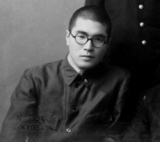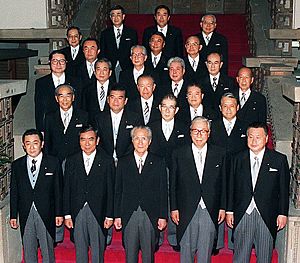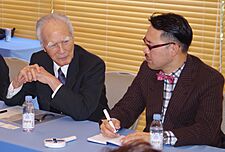Tomiichi Murayama facts for kids
Quick facts for kids
Tomiichi Murayama
|
|
|---|---|
|
村山 富市
|
|
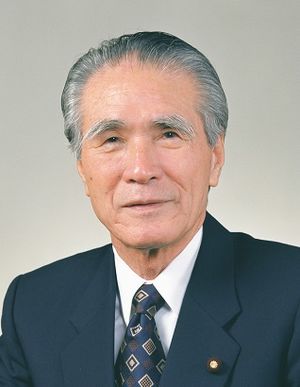
Official portrait, 1994
|
|
| Prime Minister of Japan | |
| In office 30 June 1994 – 11 January 1996 |
|
| Monarch | Akihito |
| Deputy | Yōhei Kōno Ryutaro Hashimoto |
| Preceded by | Tsutomu Hata |
| Succeeded by | Ryutaro Hashimoto |
| Chairman of the Social Democratic Party | |
| In office 25 September 1993 – 28 September 1996 |
|
| Preceded by | Sadao Yamahana |
| Succeeded by | Takako Doi |
| Member of the House of Representatives | |
| In office 19 December 1983 – 2 June 2000 |
|
| Preceded by | Tadafumi Hatano |
| Succeeded by | Ban Kugimiya |
| Constituency | Former Ōita 1st (1983–1996) Ōita 1st (1996–2000) |
| In office 11 December 1972 – 19 May 1980 |
|
| Preceded by | Sakae Aizawa |
| Succeeded by | Tadafumi Hatano |
| Constituency | Former Ōita 1st |
| Member of the Ōita Prefectural Assembly | |
| In office 1963–1972 |
|
| Constituency | Ōita City |
| Member of the Ōita City Council | |
| In office 1955–1963 |
|
| Personal details | |
| Born | 3 March 1924 Ōita, Japan |
| Died | 17 October 2025 (aged 101) Ōita, Japan |
| Political party | Social Democratic (1996–2025) |
| Other political affiliations |
Left Socialist (1951–1955) Socialist (1955–1996) |
| Spouse |
Yoshie Murayama
(m. 1953) |
| Alma mater | Meiji University |
| Signature | |
| Military service | |
| Allegiance | |
| Branch | |
| Service years | 1944–1945 |
| Rank | Officer candidate |
| Conflict | World War II |
| a. | |
Tomiichi Murayama (born March 3, 1924 – died October 17, 2025) was an important Japanese politician. He served as the Prime Minister of Japan from 1994 to 1996. He was the first leader from the Socialist Party to become prime minister since 1948.
Murayama is best known for the Murayama Statement. This was an official apology he made in 1995. It marked 50 years since the end of World War II. In this statement, he expressed deep regret for Japan's actions in other countries during the war.
Born in Ōita Prefecture, Murayama studied at Meiji University. He later worked to help workers in labor unions. He began his political career by being elected to the Ōita City Council in 1955. He then moved on to the Ōita Prefectural Assembly and the National Diet.
In 1994, he became prime minister. His government was a special team-up of different political parties. During his time as prime minister, he focused on the Murayama Statement. His government also faced big challenges, like the Great Hanshin earthquake and the Tokyo subway sarin attack in 1995. He stepped down as prime minister in 1996. He later helped change his party's name to the Social Democratic Party.
Contents
Early Life and Education
Tomiichi Murayama was born in Ōita Prefecture on March 3, 1924. His father was a fisherman. He was one of eleven children. When he was fourteen, his father passed away. This meant Tomiichi had to work to help his family. He delivered newspapers and took on other small jobs.
After finishing high school in 1938, he moved to Tokyo. There, he worked at a printing factory during the day. At night, he continued his studies at the Tokyo Municipal School of Commerce.
In 1943, he started studying philosophy at Meiji University. However, in 1944, he was called to help with the war effort. He worked in shipyards and later joined the Imperial Army. After World War II ended, he left the army. He then finished his degree at Meiji University in 1946.
After college, Murayama worked to support young people in fishing villages. He later became a leader in the Oita Prefectural Employees' Labor Union. This showed his early interest in helping others.
Political Journey
Murayama first tried to join the Oita City Council in 1951 but was not elected. In 1953, he married Yoshie Murayama. He tried again in 1955 and was successfully elected to the Oita City Council as a member of the Japan Socialist Party. He served there for eight years.
In 1963, he was elected to the Prefectural Assembly of Oita, serving for nine years. His political career continued to grow. In 1972, he was elected to the National Diet, which is Japan's parliament. He was re-elected many times.
Becoming Prime Minister
In 1993, a general election changed Japan's political scene. The ruling LDP lost many seats. New parties also emerged. After some political changes, a new government was formed without the LDP.
The leader of Murayama's party, the Japan Socialist Party (JSP), stepped down. Murayama was then chosen as the new leader of the JSP. After more political shifts and resignations of other prime ministers, a big decision had to be made.
In 1994, different parties discussed forming a new government. Murayama was chosen to lead a special team-up of parties. This made him the first Socialist Prime Minister since 1955. His rise to power was seen as quite surprising.
Leading the Country (1994–1996)
The government led by Murayama was a "coalition government." This meant different political parties worked together. This was a big step in ending long-standing political disagreements in Japan.
When he became Prime Minister, Murayama spoke about his goals. He wanted "people-friendly politics" and "peace of mind politics." These ideas aimed to make life better and more secure for everyone.
The Murayama Statement
One of Murayama's most important actions was the Murayama Statement. This happened in 1995. It was a special message to mark 50 years since the end of the Pacific War. In this statement, Murayama officially apologized for Japan's past actions. He spoke about the "invasion" and "colonial domination" in Asia during the war.
This statement became very important. All prime ministers after Murayama have said they will follow it. It is now seen as the official view of the Japanese government on its wartime history.
Reactions to the Statement
Murayama said he was "stating the obvious thing" with his apology. He hoped future leaders would respect it, and they did. The Murayama Statement is Japan's official understanding of its history.
Some politicians had different opinions about Japan's past actions. They were sometimes criticized by countries like China and South Korea. These politicians felt Japan had already apologized enough.
In 2008, a high-ranking military official, Toshio Tamogami, wrote a paper that disagreed with the statement. He was removed from his job. This showed how important the Murayama Statement was to the government.
Before becoming prime minister, Shinzo Abe had also questioned the statement. However, in 2015, he said his government would respect it. He also wanted to make a new statement focused on the future.
Helping Women Affected by War
In 1994, Murayama's government announced a plan to help women and families. These were people who faced difficult circumstances during World War II due to actions by Japanese soldiers. In 1995, the Asian Women's Fund was created. Murayama strongly supported this.
This fund aimed to provide support using private donations. This was because using government money for such issues was complicated. Murayama believed it was important to show sincere feelings of apology from the Japanese people. He wanted to help these women while they were still alive.
Murayama later became the president of this fund. The fund worked on projects to support women's dignity. It officially closed in March 2007, after completing its work in several Asian countries.
International Relations
With the United States
When Murayama became prime minister, the US President, Bill Clinton, was a bit unsure about a Socialist leader. But after Murayama shared his life story, President Clinton seemed to feel more positive.
In 1994, Murayama made a big announcement. He said that Japan's Self-Defense Forces were allowed by the constitution. He also confirmed that the Japan-U.S. Security Treaty would continue. This was a change for his party and made the treaty a key part of Japan's foreign policy.
In 1995, Murayama visited the White House. He and President Clinton held a joint press conference. However, the relationship between Japan and the United States faced some challenges during his time.
National Policies
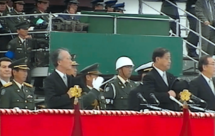
Nobuo Ishihara, a key government official, praised Murayama's government. He said it handled many long-standing national issues. These included reforms and new laws to help citizens.
Recycling Law
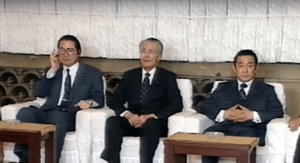
Under Murayama, a law was passed to promote recycling. This law made it mandatory to separate recyclable items from other trash. This helped Japan become more environmentally friendly.
Narita Airport Issue
The Sanrizuka Struggle was a long-running disagreement about Narita International Airport. By Murayama's time, the protests were less violent. In 1995, Murayama apologized to the local community for the problems caused by the airport's construction. This apology helped to resolve some of the issues. It also made it easier to acquire land for future airport expansion.
Family Names
Murayama strongly supported a system that allowed married couples to choose. They could keep their original family names if they wished.
Strengthening the Prime Minister's Office
Murayama wanted the Prime Minister's Office to make more political decisions. He created a new role called "Assistant to the Prime Minister." These assistants were politicians who advised the Prime Minister. This helped bring more political input into government decisions.
Resignation
As part of the agreement between the parties in his government, Murayama decided to step down. He announced his resignation on January 5, 1996. This allowed Ryutaro Hashimoto, the leader of the Liberal Democratic Party, to become the next prime minister. Murayama retired from politics completely in 2000.
Later Life and Passing
After leaving politics in 2000, Murayama continued to be active. He traveled to North Korea in 2000 with Mutsuko Miki. Their goal was to improve relations between the two countries.
He also became the president of the Asian Women's Fund. This organization provided support to women affected by past conflicts. The fund completed its work and was dissolved on March 31, 2007.
Tomiichi Murayama celebrated his 100th birthday on March 3, 2024. He passed away on October 17, 2025, at a hospital in Oita. He was 101 years old. His wife, Yoshie, whom he was married to for 71 years, passed away in 2024. He is survived by his two children, two grandchildren, and five great-grandchildren.
Legacy
After his passing, The New York Times highlighted his important speech. His address on the 50th anniversary of Japan's surrender in World War II set a standard. It showed his country's "deep remorse" for wartime actions. The newspaper noted that Murayama went further than previous Japanese leaders. He expressed regret for the suffering caused in countries Japan occupied.
Murayama's national apology became a guide for future Japanese leaders. His successors used similar words like "deep remorse" and "heartfelt apology." They used these phrases when marking later anniversaries of World War II.
Chinese spokesperson for the Foreign Minister Lin Jian called Murayama "a politician with a strong sense of justice." He also recognized Murayama's positive impact on Japan-China relations. President of South Korea Lee Jae Myung praised Murayama. He said Murayama made "exceptional efforts toward reconciliation and co-prosperity with neighboring countries."
Social Democratic Party Chairwoman Mizuho Fukushima called Murayama the "father of Japanese politics."
Through his work with the Asian Women's Fund, Murayama helped bring attention to the experiences of women affected by the war. The United Nations Commission on Human Rights supported these women. Later, UN Secretary-General Ban Ki-moon invited one of the survivors to speak at the United Nations headquarters.
Honours
- Grand Cordon of the Order of the Paulownia Flowers (2006)
See also
 In Spanish: Tomiichi Murayama para niños
In Spanish: Tomiichi Murayama para niños
- Fusen Ketsugi
- Murayama Cabinet
- The Nobel Peace Prize for Article 9 of the Japanese Constitution


